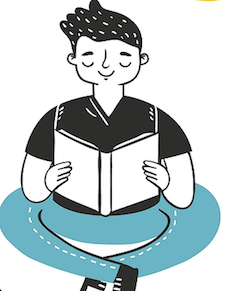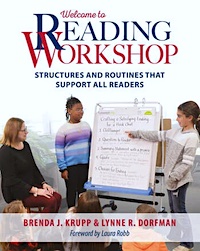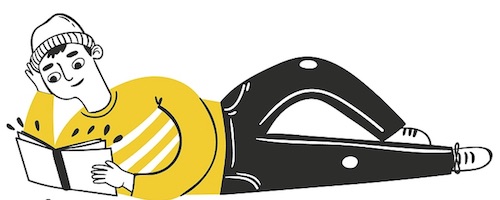Want Kids to Read More? Give Them Time!
Independent reading time. Time for students to read a book they have chosen, time to practice skills and strategies that have been taught, time to talk about books and reading with their teacher … time to be immersed in the joy of reading.
Allyn and Morrell tell us, “Reading is a great equalizer that has the power to break down the typical barriers to education, those invisible walls built around coveted zip codes and elite institutions.” (2016, 18).
If we want all our students to be successful in finding the time to read daily, we need to give them this time in our reading block. This routine helps students develop positive attitudes about reading through a wide range of interesting choices that increase motivation and engagement for reading.
A quarter-hour can make a difference
But how much time is enough to make a difference? According to the International Literacy Association, “As little as 15 minutes of in-school reading has a profound impact; students who read independently for that amount of time significantly increased their reading performance, with more profound gains for below-average readers.”
Without this frequency and duration, students may not develop appropriate stamina. Richard Allington, past-president of ILA and a noted reading researcher (2002, 742) notes that “Extensive reading is critical to the development of reading proficiency.”
Nancie Atwell calls it “the reading zone” — that space in time when students get “lost in a book” and are not aware of the passing of time. This zone experience is one that all readers need to have to become passionate about reading. Additionally, reading “in the zone” is a way to reduce stress and escape with the help of our reader imaginations and the wonderful words of authors who spin stories of adventure, mystery, friendship, and love.

Yet our challenged readers do not rush home from school to curl up with a good book. We cannot be sure they are actually doing any reading at home. It’s distressing but understandable that busy parents may sign reading logs without really checking in with their children. But if we build in time to read independently at school, we can help students find a good book (if they need that help) and observe readerly behaviors to guide them to become more skilled at being a proficient reader.
With practice, reading can become a pleasure
Independent reading block is a time for students to consciously and subconsciously practice the strategies and skills they’ve learned in mini-lessons, and it’s the time when teachers are differentiating instruction through roving conferences and small-group instruction.
In Good Choice!: Supporting Independent Reading and Response K-6, author/educator Tony Stead reminds us that when we create “a time for independent reading from the onset of the school year, children not only build up stamina for reading, but also see it as an important and pleasurable component of their daily lives.” (2008, 5)
In part, our students learn to read by reading. With access to a wonderful classroom and school library and daily time to read books they select to read, students will grow as readers and develop a lifelong reading habit.

You might consider bringing the class together to create an anchor chart that lists what a reading workshop looks like, sounds like, and feels like. For children who have had workshop experience, this exercise reminds them of reading habits that have been used successfully in previous classrooms. It becomes a place to begin and can be added to throughout the year.
Children who are new to a workshop format will need more time and teacher modeling to learn habits that increase reading stamina and reading focus. Helping children read independently for extended periods of time is one goal for the workshop. Jennifer Serravallo reminds us in her book The Reading Strategies Book: Your Everything Guide to Developing Skilled Readers that if children are not reading during independent reading time they will not make the progress we are hoping for and working for. “Engagement is everything,” she says. (pg. 44)
Strategies to build reading stamina
Helping students increase their stamina – the amount of time they can sustain their reading – becomes part of the work done in independent reading blocks. Young people need realistic time expectations and strategies to help them increase their reading stamina. These strategies become procedural mini-lessons, small group instruction opportunities, or individual conference focus points.
Strategies to build stamina can range from finding a smart place to read (in order to concentrate) to figuring out your next steps as a fiction or nonfiction reader. If you’re planning to read for research purposes, then you are thoughtfully gathering your tools and resources to sustain stamina for the work at hand.
One strategy you might try is creating a class graph that shows the number of minutes the class read during independent reading time. Students will see the bars grow over time and feel their success as a community of readers.
Older students are able to keep their own graphs. They are often capable of noting specifically the number of minutes they were actually reading and when they were engaged in an activity that took their eyes off the text. (For example, when they were engaged in creating a written response, or in a book club discussion, or during small group instruction.) Reading the graph and drawing conclusions from the data is important and could be used to set class goals as well as individual goals.
What are the teachers doing?
While many teachers like to begin this time by reading from their own personal selections – modeling that they too are lifelong readers – most of their time is spent in small group instruction and one-on-one reading conferences.
Teachers often transition from the mini-lesson to independent reading time by conducting a “status of the class.” We’ve read about status of the class in Nancie Atwell’s The Reading Zone, 2nd Edition: How to Help Kids Become Skilled, Passionate, Habitual, Critical Readers (2016) and in Donalyn Miller’s Reading in the Wild: The Book Whisperer’s Keys to Cultivating Lifelong Reading Habits (2014). This formative assessment routine can help teachers easily track how their readers are spending their independent reading time.
Before independent reading time, call on each of your students to give you the title of the book they are reading and the page number. You will also record the date. You can also record if they have “F” finished a book, “A” abandoned a book, “S” are ready to start a new book, or “C” are ready for a conference with you.
This information can help you praise students who are completing a book and encourage students who are moving slowly. You might want to check in with those students who are not finishing a book for a long period of time to see if you can offer support. In three or four minutes, you know what all your students are reading! This frequent record helps you communicate with your students about the books they are reading, perhaps suggesting a book that is less challenging but about the same topic, or by helping them explore a new genre.
You might begin with a roll call each day (or several times a week) and move to an online version of status of the class after the first several months of the school year. Return to a roll call for the last month or two of school when your seasoned readers can greatly benefit from learning about new book titles their peers are reading. Add an “R” for recommend this book to your status reporting to encourage others to try out something new.

During the first six to ten minutes of independent reading time, everyone is silent. As you circulate, you can observe students who are flipping back to reread or review information or the storyline events or who are staring at one page for a long period of time. Some readers may jot notes or write in their response journals. You may notice certain students who move quickly through their pile of selected books, from one to the other, without ever really reading any of them. Others will be deeply engrossed in one book and stay with it all week or even for a two-week period until it is finished.
You may start to understand that some students are engaged in “fake reading” – simply turning pages to be compliant. Others “read” the illustrations and text features. Jot important observations on sticky notes and transfer to an electronic file or notebook when you have a chance, preferably that same day. Your notebook can have two columns – one for the sticky note(s) and date and the other column for you to translate into possible mini-lessons for the whole group, opportunities to extend learning through small group instruction, or future reading goals. Kid-watching also leads to other work a teacher does to differentiate instruction during independent reading time – the work of conferring and feedback.
How much do you value independent reading?

How does the amount of independent reading time provided by your schedule reflect your value of reading?
Reference notes
► Literacy Leadership Brief: The Power and Promise of Read Alouds and Independent Reading, International Literacy Association, 2018, pg. 5
► Atwell, Nancie. The Reading Zone: How to Help Kids Become Skilled, Passionate, Habitual, Critical Readers, 2007 (Scholastic)
► Stead, Tony. Good Choice!: Supporting Independent Reading and Response K-6, 2008 (Stenhouse)
► Serravallo, Jennifer. The Reading Strategies Book: Your Everything Guide to Developing Skilled Readers, 2015 (Heinemann)
► Miller, Donalyn. Reading in the Wild: The Book Whisperer’s Keys to Cultivating Lifelong Reading Habits, 2014 (Jossey-Bass)
Lynne R. Dorfman is an adjunct professor for Arcadia University, a co-editor for Pennsylvania Reads: Journal of the Keystone State Literacy Association, and a co-director of the PA Writing & Literature Project.




































